8A Unit 1 checkout Teaching__ plan
- 格式:doc
- 大小:48.00 KB
- 文档页数:4
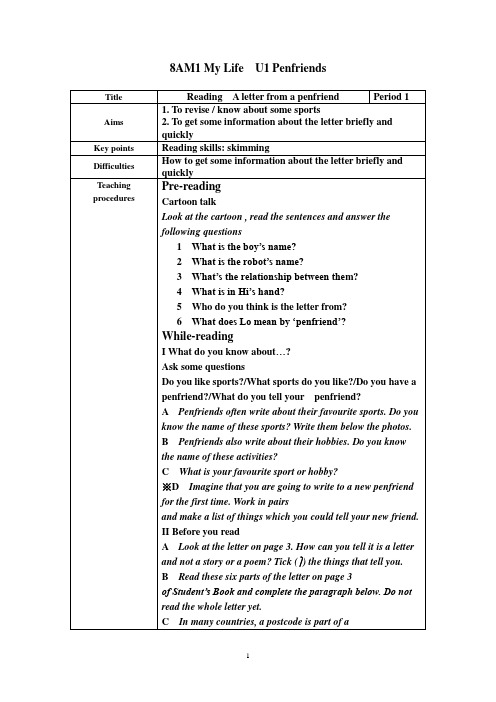
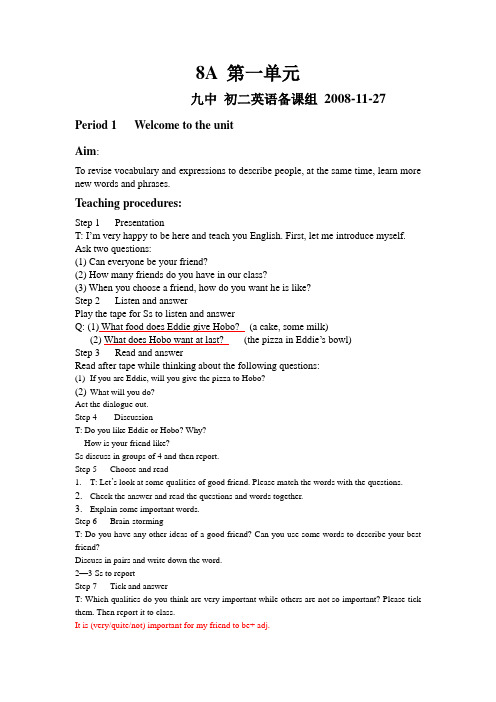
8A 第一单元九中初二英语备课组2008-11-27 Period 1 Welcome to the unitAim:To revise vocabulary and expressions to describe people, at the same time, learn more new words and phrases.Teaching procedures:Step 1 PresentationT: I’m very happy to be here and teach you English. First, let me introduce myself. Ask two questions:(1) Can everyone be your friend?(2) How many friends do you have in our class?(3) When you choose a friend, how do you want he is like?Step 2 Listen and answerPlay the tape for Ss to listen and answerQ: (1) What food does Eddie give Hobo? (a cake, some milk)(2) What does Hobo want at last? (the pizza in Eddie’s bowl)Step 3 Read and answerRead after tape while thinking about the following questions:(1)If you are Eddie, will you give the pizza to Hobo?(2)What will you do?Act the dialogue out.Step 4 DiscussionT: Do you like Eddie or Hobo? Why?How is your friend like?Ss discuss in groups of 4 and then report.Step 5 Choose and read1.T: Let’s look at some qualities of good friend. Please match the words with the questions.2.Check the answer and read the questions and words together.3.Explain some important words.Step 6 Brain-stormingT: Do you have any other ideas of a good friend? Can you use some words to describe your best friend?Discuss in pairs and write down the word.2—3 Ss to reportStep 7 Tick and answerT: Which qualities do you think are very important while others are not so important? Please tick them. Then report it to class.It is (very/quite/not) important for my friend to be+ adj.Step 8 SummarizeT: Today we have learned some important qualities about a good friend. It seem that we all think appearance is not so important, but he should be helpful and honest. And I hope everyone can be like that and you will have more friends.Period 2Aim:To use different strategies to help students to understand the text;To learn how to use adjectives to describe people’s appearance and characteristics. Teaching procedures:Step 1 Revision.1.What are the most important qualities of a good friend?2.What are the very important qualities of a good friend?3.What’s your good friend like?Step 2 Presentation1.T: I have a good friend. Do you want to know her? What do you want to knowabout her?2.Show a picture. Describe my good friend. Introduce some new expressions:As tall as; be willing to; have a good sense of humor; feel boredStep 3 Fast readingT: ‘Teenagers’ magazine is holding a writing competition. Some students have written some entries for it. Please read and find out their main qualities.1---generous, helpful2---humorous (have a good sense of humor), funny3---true friend, kindStep 4 Read for details1. T: So we have got a table about them. And you have known a lot about them. Canyou say sth about them according to the information in the table.2. Give Ss 3 minutes to prepare3. Ask 2-3 Ss to retell the three articles.Step 6 Brainstorming.1. T: Well, when we describe our friends, we also need to describe what he or she is like. What kind of words can we use? ---Adjectives.Eyes, nose: big, smallFace: round, squareBody: thin, strong, slim, fat, tall, shortHair: short, long, straight, circled, shoulder-length2. We can use so many useful words to describe people. Is there any difference in describing boys and girls? Can you give me any examples?(write down some words in the list on Page 7)Homework:1.To write about one of their friends. (in the next class, teachers can read some ofthem and ask the whole class to guess who she/he is)2.(for some weak students) To write a short passage, use any one on Page 4 as amodel. They can replace some words in it if they can’t write a new one.Period 3Aim:To learn some useful expressions and use them in different contextTo learn how to describe their friends .Teaching procedures:Step 1 RevisionT: We have learnt some words to describe your friends, can you introduce your friend to us? Others please guess who it is?Ask 3-4 Ss to read their articles.Step 2 Some more exercises1. T: Let’s meet our old friends again. Mr Zhou has some problems in describing them. Can you help him finish his sentences? Do Exe B2 on P52. Find out their photos according to Mr Zhou’s description.3. Mr Zhou is writing some notes about them. Is he right?4. V otingSuppose you are going to vote for the best friend among these three students, what is your choice? Why?Step 3 V oting in your own classDo you have such a good friend in you class, or around you? Please vote for him or her, and tell us your reason. (talk about qualities)Step 4 Language points1.T: now let’s look at some useful expressions in the passages.Give Ss some phrases for them to translate:与…一样苗条as slim as乐于做某事be willing to do sth.准备好做某事be ready to do sth.帮助我做家庭作业help me with my homework因为太多工作because of too much work戴眼镜wear glasses有很好的幽默感have a good sense of humour感到厌倦feel bored使我笑make me laugh走路经过walk past撞翻knock over说某人坏话say a bad word about sb.Read them together, and ask Ss to use some of them to make sentences.2. T: Do you have any problem in the passages?3. Answer any question Ss may haveStep 5 Practice1. Fill in the blanks with the right word• 1. Thank you for giving me the information. Y ou are so ________(help).• 2. He plays the piano well. His parents think he’s very _______(music).• 3. Are you _______(will) to sing us an English song?• 4. Maybe he will grow into a successful ______(sing).• 5. Have you ever been to the sea village ______(call) Mingshu ?• 6. He has a __________(wonder) friend Millie.plete the sentence(1) Max 很有幽默感.他讲有趣的笑话,总使我发笑.Max ______________________. He tells _________and always _____________.(2) 当我读到你的广告时,我想起了我的好朋友May.I ________ my great friend May when I ___________________.(3) 她从不说任何人的坏话.She never ______________ about______.(4) 她总是帮我学英语.She always ______ me _______ English.(5) Jim是一个慷慨大方的人,他总是乐于助人.(6) Betty长大后想周游世界.3 .Correct the mistakes• 1. My father has good sense of humour.• 2. I never feel boring when I am with him.• 3. My friend is a ture friend.• 4. Lily wants us to help her skating.• 5. The glasses make Max looks smart.Step 6 ConclusionAsk Ss to make a conclusion of what we have learned in this period.Homework:1.Write a compos ion about his/her best friends.2.Finish off the exercises in Handbook Period3.Period 4 V ocabularyTeaching Aims:To learn how to use adjectives to describe people, especially how to describe boys and girls appropriately.Teaching procedures:Step 1 Lead-inRevise sth about Reading parts to go over the 3 Ss’ personalities.Step 2 Adjectives.1. So we can use different adjectives to describe different things. What about a tree, a building, a classroom …?Can you tell me some other adjectives to describe different things?…2. Show some pictures to teach the different words of describing people’s appearance.e.g: tall/short, square/round face, straight/wavy hair, slim/fat, plump3.PartAStep3 Extensive activitiesGet Ss to find more adjectives for each category ,e g:Build:Eyes:Nose:Face:Hair:Divide Ss into some groups to write more words.Step4 Presentation1.Discuss the adjectives to describe boys and girls, then do PartB2.Play a gameStep5 Exx and HomeworkPeriod 5Teaching Aims:To use comparatives and superlatives to compare two or more people and things; Teaching procedures:Step1 Lead-in1.T: We use adjectives to describe people and things. We can put it before a noun or after a linking verbs.Present this by revising the three Ss ‘ appearance, trying to choose the adjectives tointroduce them,then show them just like : a clever girl, an interesting story2. Present linking verbsStep2 Comparatives and superlatives1. If they are alike, how can we tell their difference?E.g. Millie has long hair, Sandy has long hair, too.We can say ‘Millie has longer hair than Sandy.’(on Bb)Millie is slim. Sandy is slim, too.---‘Millie is slimmer than Sandy.’(on Bb)(Show a lot of pictures to teach them the changing rules and drills), PartB2.Work out the ruleWhen we compare two things, we use comparatives, and we put ‘than’ _____ t he comparatives.When we compare more than three things, we can use superlatives, and we can put ‘the’ _____ the superlatives.3. A is taller than B. B is taller than C. So we can say A is the tallest of the three. (give more examples, make sure Ss can understand the difference between comparatives and superlatives)Step 4 Practice1. Ask Ss to compare their classmates, using comparatives and superlatives.2. Show them some pictures, asking them to compare them.3. Show them a table, asking them to compare the things in different ways.(PartB2) Step 5 Consolidation Finish off the exercisesStep6 HomeworkCompare things and make 5 sentences using comparatives and superlatives. Period 6Teaching Aims:To compare two people or things using ‘(not) as … as’.Teaching procedures:Step1 RevisionI.1. PresentationLook at Millie and Amy, who is taller? Millie is as tall as Amy.Peter is taller than Simon. We can also say ‘Simon is not as tall as peter.’(use these sentences as model, try to lead out the meaning of ‘(not) as tall as’Practice more so that Ss know how to use ‘… than’ and ‘(not) as … as’.2. Practice using ‘… than’, ‘the most…’, ‘as…as’, ‘not as … as’.AmyVdiving swimming hiking cyclingskiing campingV ery dangerous not dangerous hiking skiing cycling swimmingdiving campingT: Amy thinks diving is the most interesting outdoor activity.It’s more interesting than swimming and hiking.Hiking is as interesting as camping. But they are not as interesting as skiing and swimming….(Ss repeat after the teacher first, and then practise in halves. After they can do it quite well in groups, ask them to practise in pairs.)3. Practise it in another way.Now can you understand another kind of diagram?Just now, we know which outdoor activity Amy likes best, which she doesn’t like. What about other students? Do you want to know their hobbies?(Show them the diagram on P11. Help them understand it and then talk about it in groups. Then ask them to practise as the four children)5. Talk about their own hobby.What about yourselves? Can you draw some stars in the table to tell us which you like best and which you don’t like?(after they finish drawing) now I want sb. To tell us his or her hobbies. At the same time, the others listen carefully and draw proper stars to show his or her hobbies. 6. Finish the sentences on P11 and do other exercises (PPT)II.Hw.Design a diagram, including 5 outdoor activities they want to talk about, using stars to show which one is the most interesting and which one they are not interested in. Then write as least 4 sentences, using ‘… than’, ‘the most…’, ‘as…as’, ‘not as … as’Period 7 Integrated skillsAim: To get specific information from a listening material;To talk about a friend.To talk about future plansTeaching procedures:I.Revision1. We have learnt a lot about different outdoor activities. What are they? (swimming, hiking, camping, diving, cycling, skiing…) What do you like doing? What would you like to do when you grow up?(Ask two pairs to talk about what they have learnt in the last lesson. The other students will listen to them and try to write down their answers in the proper boxes,think it is very interesting and it’s good for our health. I also like swimming and diving. But I am not good at swimming. So I dare not to swim or dive in the water. In the future, I would like to have a swimming lesson and try to dive in the sea. I don’t like cycling at all. But I must ride a bike every day, or I will have to spend too much time on buses. I would like to drive a car in the future if I can.)2. Ask Ss to share their answers with each other to see if they have got the right ones.3. Ask Ss some questions about the table, e.g.:What does … like doing?What would … like to do in the future?II.Task I Millie’s future plans1. Just now, … talked about their hobbies and their future plans. It’s really interesting. Our friend Millie is also talking to Amy about her future plans. Can you find out what she would like to do in the future? Y ou can listen to their conversation and puta tick in the correct boxes in the table.2. Listen to the tape again and check their answers.3. Suppose you are Millie. A reporter from NJTV is interviewing you. Please make a dialogue with your partner, talking about your future plan.4. Now you are quite familiar with Millie’s future plan. Please help her complete a letter.III.Sandy’s future plans1. So Millie would like to be a social worker when she grows up. She is really kind and helpful. What about Sandy? What would Sandy like to do when she grows up? Does she also want to be a social worker? If not, what’s her plan? Please listen to the tape and find it out.2. Listen to the tape again and help Sandy complete her letter.IV.Speak up, talking about friends.1. Sandy is showing Helen some pictures of her friends. Do you know what they are talking about? Please listen and answer:Whom are they talking about?✧What would Peter like to do in the future?2. Listen and repeat.3. Do you have any interesting pictures? I’m sure you do. Would you like to take them out and share them with your partners? (Practice in pairs, talking about their appearance and their own plans, using some pictures of their family or their friends) V.HomeworkWrite at least 5 sentences to show what they like and what they would like to do in the future.Period 8. Study skillsTeaching aims:To find the main points of a passage in order to understand and memorize it more easily.To identify keywords in order to develop general understanding of a passage.To guess meaning and generate mental pictures.Teaching procedures:Step1. Revision:Help the students to revise how to talk about their future plans.Ask: 1. Do you have any future plans?2. What are you going to do when you grow up?3. Why?4. What will you do to fulfill your aims?Ask some students to talk about it orally in class.Step2. lead- in1.Present the task today by playing a game.●Divide the students in four groups,●The teacher gives the first student a paper on which there’s a story, ask the firststudent to read it carefully and then pass the story on orally.●At last ask the last student to tell the story that he get to the whole class, and thenthe teacher will read the story to class, ask them to find out the differences between the two stories.2. Make a conclusion, tell the students when we are reading , we should payattention to some main points, generally speaking, the main points are about the questions below:●What is it about?●Who is it about?●What happened?●When did it happen?●Why did it happen?●How did it happen?Step3. Reading.Ask the students to open the book on page 14, and read the letter on page 14. try to find out information about the questions above.Who: Cindy---a grade 8 studentWhere: Bei jing Sunshine Secondary SchoolWhat: move to a new school, have problems with her new schoolWhy : Don’t know school very well, have no friends, do not know how to talk to her new friends,How: feel uncomfortable, nervous; always stay aloneAsk the students to underline the main points with the help of the table above.Step4. RetellingAsk the students to retell the letter with the help of the key words on the blackboard. Step5. Consolidation exercisesProvide one more reading for the students to practise.Homework:●Hand book: period 8●Preview the new words in main task.Period 9 Main taskAim: To plan ideas for writingto learn the proper and easy ways to write something;to write a description of the appearance and personality of a friend.Teaching procedures:I.RevisionIn this unit, we have learnt a lot about how to describe our best friends. Show three photos of Betty, Max and May. Ask some students to describe them. Revise some useful words and expressions.Ask: What aspects can we talk about from when we talk about our best friends?What’s his/her name?What’s he/she like?What’s his/her quality of a good friend (personality)?What does he/she like doing?What would he/she like to do in the future?Please keep them in your mind. We will talk about them step by step.II.Brainstorming.1. When you want to talk about sth, what do you feel difficult to do? Proper words and phrases.So we need to gather enough words about sth. when we want to talk about it. How many words do you know that we can use to describe our friends? Let’s do it in groups. Please show us you are the best.After it, T collects their words on the Bb and decide which group is the winner.2. Go through the words in the table on P15.3. Read the passage on P16 quickly and find out some information about Daniel’s best friend4. Group work. Find out the useful words about how to describe the best friends( eg. tall, slim; square, long; bright, smiling; pretty, kink; clever, help, happy)III.Phrases and sentencesNow we have these words. Is it enough to write a passage? No. So we stillneed some phrases and sentences structures. Try to find the phrases and sentences Daniel used in his passage.IV. Paragraphs1. ElicitOK. I’m going to write about my good friend.…is my best friend. ……(put these phrases and sentences together randomly)(ask for their opinion about this ‘passage’)So the structure of a passage is very important.2. Ask Ss to find out the structure of the passage by themselves. T can help them when needed.Introduction—Body(appearance—personality and ability)—Conclusion(hobbies and future plans)IV.Go back to the beginning of this class.Have we learnt how to write about these in this unit? Can you remember what we talked about at the beginning of this class?What’s his/her name?What’s he/she like?What’s his/her quality of a good friend (personality)?What does he/she like doing?What would he/she like to do in the future?Are you ready to write about your good friends? Let’s have a try. (They can talk about sb in the class in groups first. In this way, the weak students will know what to write and how to write it.)V.Writing and checkingAfter they finish writing, use some of their passages as a model. Show them to the whole class and ask the other students to find out the good points in each passage. After talking about some passages, ask them to rewrite their passages to make them better.VI.Hw.Write a passage about their good friends.Period 10 CheckoutAims: to review what they have learnt in this unit;to assess their understanding and correct use of adjectives, comparatives and superlatives.This is the check out of the whole unit. That means the most important language points in this unit are using adjectives to describe something and using ‘(not) as … as’to compare two things. So we need to design some exercises to practise using them and make sure that students can use them fluently.Usually I ask them to make some sentences, talk about some topic, and look back on what we have learnt in this unit. Sometimes I also ask them to do some translations. It is useful to learn a foreign language, especially to those who can’t study well enough. After that, I use this page as a short test. I ask them to do it in 5~10 minutes, thencheck the answers immediately. To do so, students can have more confidence in themselves and know better about themselves in time.Teaching procedures:I . RevisionAsk some students to read their passages to the class. Get Ss to discuss the adjectives and some set phrases in their passages.Brainstorming the useful vocabulary about how to describe the best friendII. CheckoutDo Part BDo additional exercise (Fill in the blanks with proper words)III. Make a surveyRevise the comparatives and superlatives. ( Write down the comparative and superlative form of the following words)Group work. Make a survey about the classmate s’ opinion of different activities, different objects using the comparatives and superlatives.IV.CheckoutDo Part A(Have a competition)Group work. Make up an interesting story using the adjectives, the comparatives and superlatives.V.ConsolidationDo some additional exercisesVI.HomeworkRevise the contents in this unit.。
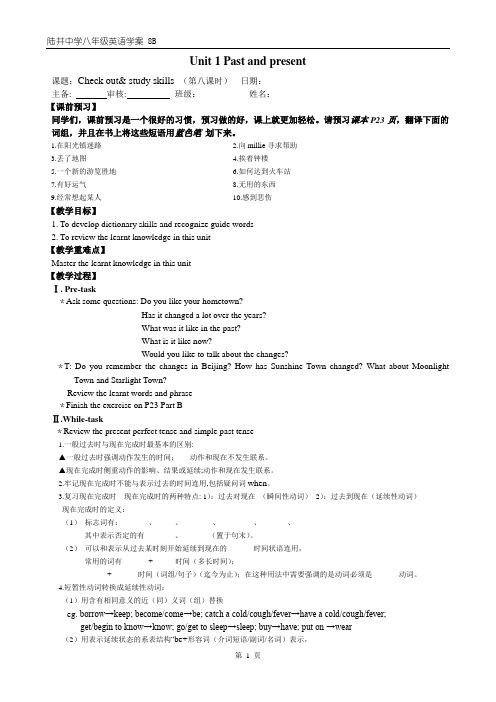
Unit 1 Past and present课题:Check out& study skills (第八课时)日期:主备: 审核: 班级:_________ 姓名:_________【课前预习】同学们,课前预习是一个很好的习惯,预习做的好,课上就更加轻松。
请预习课本P23页,翻译下面的词组,并且在书上将这些短语用蓝色笔划下来。
1.在阳光镇迷路_________________________________2.向millie寻求帮助________________________________3.丢了地图____________________________________4.挨着钟楼_____________________________________5.一个新的游览胜地____________________________6.如何达到火车站_________________________________7.有好运气____________________________________ 8.无用的东西____________________________________9.经常想起某人________________________________ 10.感到悲伤_____________________________________【教学目标】1. To develop dictionary skills and recognize guide words2. To review the learnt knowledge in this unit【教学重难点】Master the learnt knowledge in this unit【教学过程】Ⅰ. Pre-task*Ask some questions: Do you like your hometown?Has it changed a lot over the years?What was it like in the past?What is it like now?Would you like to talk about the changes?*T: Do you remember the changes in Beijing? How has Sunshine Town changed? What about Moonlight Town and Starlight Town?Review the learnt words and phrase*Finish the exercise on P23 Part BⅡ.While-task*Review the present perfect tense and simple past tense1.一般过去时与现在完成时最基本的区别:▲一般过去时强调动作发生的时间;动作和现在不发生联系。
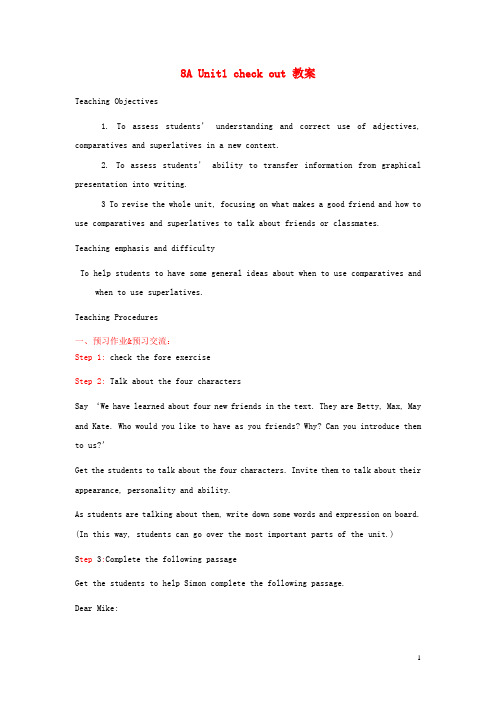
8A Unit1 check out 教案Teaching Objectives1. To assess students’ understanding and correct use of adjectives, comparatives and superlatives in a new context.2. To assess students’ ability to transfer information from graphical presentation into writing.3 To revise the whole unit, focusing on what makes a good friend and how to use comparatives and superlatives to talk about friends or classmates.Teaching emphasis and difficultyTo help students to have some general ideas about when to use comparatives and when to use superlatives.Teaching Procedures一、预习作业&预习交流:Step 1: check the fore exerciseStep 2: Talk about the four charactersSay ‘We have learned about four new friends in the text. They are Betty, Max, May and Kate. Who would you like to have as you friends? Why? Can you introduce them to us?’Get the students to talk about the four characters. Invite them to talk about their appearance, personality and ability.As students are talking about them, write down some words and expression on board. (In this way, students can go over the most important parts of the unit.)S tep 3:Complete the following passageGet the students to help Simon complete the following passage.Dear Mike:I want to tell you about my best friend David. He has bad ___1__ and wears glasses because he likes sitting before the computer. He wants to be a computer __2___ when he grows up. He is very __3___ and has a good sense of __4___ I always feel __5___ when I stay with him. He is very __6___ and always helps people in __7___. I think he is a __8___ friend because he can keep a __9___ and I can tell him anything. He is a good friend to __10___ my joy. I like talking with him. What’s more,we both like basketball. He is tall and ___11__ and quite good at playing basketball. We often play together after school. We are always good __12___. Do you think he is a good friend?Please tell me your best __13___ in your school, ok?Yours Simon(key: 1.eyesight 2.programmer 3. generous 4.humor. 5. happy 6.helpful 7.need. 8. true 9. secret 10. share 11.slim 12.partners. 13.friend )S tep 4: Do some exercises1、.汉译英:(1)明天我们去干什么?去踢足球怎么样?_______________________________________________________________(2)我认为爬山要比看电视更好。

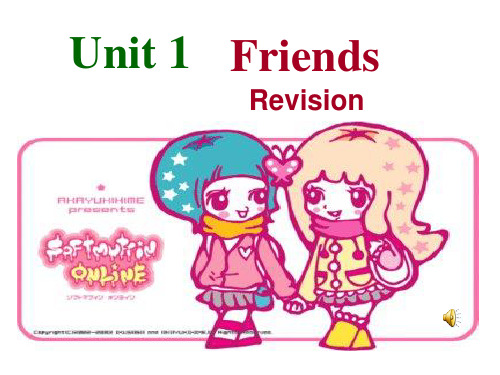
《牛津初中英语》8AUnit1教案《牛津初中英语》8A Unitl教案Teaching Plan for Reading (P3)Teaching content Unit 1 Friends ( Reading 2 )Teach ing aims1. To grasp some useful expressi ons about describ ing a pers on2. To lear n how to describe frien ds.3. To help stude nts to lear n what kind of pers on should be his/her best friend.Key poi nts:To lear n some useful expressi ons and use them in differe nt con textTeach ing difficulties:To lear n how to describe frie nds.Teach ing proceduresPart One预习作业&预习交流A: Please retell the articles and fin ish exercise C1.B:重要短语(小组核对答案---教师提示重点词组注意点---读背词组)I. 与…一样苗条 2.乐于做某事3. 准备好做某事4.帮助我做家庭作业5.因为太多工作6.戴眼镜7.有很好的幽默感8.感到厌倦9.使我笑10.走路经过II. 撞翻12. 一个忠实的朋友13.保密14.说某人坏话【教学设计说明】:检查学生预习情况,纠正错误,并对正确答案进行巩固。
Part Two交流展示&点拨提高Step1 Prese ntati onYesterday we met three friends in ‘ Teenagers ' Magazine. They ' re Betty, Max and May. How much do you remember them?学生分组讨论,组与组互问互答。
江苏译林版牛津英语8AUnit1FriendsCheckout教学设计【摘要】江苏译林版的牛津英语教材突破传统模式,充分体现了英语语言教学的整体性和综合性,教材的复习课更是具有典型性,如何充分利用对于学生知识的提升稳固有重要意义。
【关键词】教材分析复习课时教学设计一、研究问题:单元信息的整合江苏译林版牛津英语教材在编排体例上突破了传统模式,以话题为单位组织每个单元,让学生通过体验、实践、合作、交流和探究等方式,完成学习任务。
教材在每一个单元的最后都安排了一个Checkout的复习课时。
如何充分利用一个课时45分钟的教学时间,以学习者的认知规律为基础,有组织地再现单元信息,提升语言能力正是本课时所要研究的问题。
二、教材分析本课时为8A第一单元Friends的最后一个课时,是复习课。
本课时的重点是以描述人的外貌和个性为主线复习形容词、形容词的比较级和最高级。
通过本课时的学习,学习者初步掌握形容词原级、比较级和最高级的使用情境和形式。
三、学情分析学生在通过七年级第一单元的学习后已经掌握了用英语进行自我介绍的方法,新的介绍人物的话题需要得到进一步的扩充和拓展。
本课时将以元“介绍他人”为主题,在听、说、读、写四个方面全面整理并综合单元信息,巩固和提升学习者用英语介绍他人的能力。
四、教学目标1.知识目标(1)新单词,新短语,新句型.(2)语言目标:巩固形容词原级、比较级、最高级的用法。
2.能力目标(1)能就所见的人或物进行一定的描述。
(2)能就同类的人或物进行适当的比较。
3.情感目标(1)通过小组活动,培养学生竞争意识和合作精神。
(2)认识到什么样的朋友才是好朋友,能在自己的学习和生活中就“交友”这一内容进行一定认识和把握。
五、设计思路本学案根据体验、实践、参与、合作、交流和探究原则,依据培养综合语言运用能力的理念而设计。
整堂课的学习过程将以形容词及其比较级和最高级的学习为主线,调动学生的感官、思维乃至情感态度,促使学生综合运用语言能力的改善和提高。
Unit1 Teaching plan(新课标版八年级英语上册教案教学设计)Lesson One一、基本目标:句型:1)Welcome back!2) Let me call your names.日常交际:May I …?I’m sorry.It doesn’t matter.二、教具:录音机,大白纸(写上全班同学的姓名)、一张教师节卡片三、教学设计:Step 1 Part 1 Read and saySay “Welcome to school! Everybody!”拿出事先准备好的写有全班姓名的白纸,教授a piece of paper 之一短语及其他部分生词。
Teacher: What’s this in English?Students: It’s a piece of paper.Teacher: I have all your names on this piece of paper. Now let me call your names.引导学生猜测这些句子的意思。
引导听录音,听前提问Who is their English teacher?Does he know the students’ names?放一段录音,回答。
之后集体跟读对话三遍(见媒体素材音频类:第一课课文跟读)根据教材中的图片提问:What can you see in the picture?Who is late? Why?播放Part 1的视频,再让学生回答问题(见媒体素材视频类:Lesson 1 Part 1)重点内容总结:先由学生在书上自己找出用笔画上,再由教师带领,挨个说出,最后教师总结Step 2 Part 2 Read and act1)教师拿出准备好的卡片,说:Today is September 10th, Teachers’ Day.这时学生会说:Happy Teachers’ Day, Mr./Miss …学生们把自己准备好的贺卡拿出来送给教师。
《牛津初中英语》8A Unit 1 Friends Checkout主讲教师钱群南京育英外国语学校简要提示一、年级:八年级二、教学内容:8A Unit 1 Friends三、课型:Checkout四、教学目标1.知识目标1) 掌握与本单元描述人物特征话题有关的词汇及句型。
2) 掌握并能熟练运用形容词的比较级和最高级。
2.能力目标1) 能知道如何描述人的外貌。
2) 能用形容词来描述人物或事物。
3) 能掌握形容词的比较级和最高级。
五、教学重难点采用多种方法巩固、加深理解并熟练运用与本单元话题有关的语言点和语法。
教学流程Part One Language points revision (用时:18分钟)Step 1 Revision (用时:5分钟)We know this unit is about friends. 我们都知道这一单元的中心话题是关于朋友。
After learning this unit, we should know how to use adjectives to describe our friends’general appearance, personality and abilities.学完这一单元后,我们应该知道如何用形容词来描写我们朋友的外貌、个性和能力。
And we should also learn to introduce our friends. 我们还应该学会介绍我们的朋友。
First, let’s look at these pictures and talk about them.首先,下面让我们来看这些图片并谈论他们。
A is strong.B is thin.A has big eyes.B has small eyes.A is short.B is tall.A has a square face.B has a round face.Step2 Practice (用时:5分钟)OK, now you’ll see three persons in a group. I’ll describe one of them, listen carefully, then try to choose the right one.现在看这些人物,我将会描述他们,仔细听,从三副画中选择我所描述的人。
Teaching plan
Teaching contents: 8A Unit 1 Friends Checkout
Teaching aims and demand :
1.To revise how to describe a person with some adjectives
2.To revise some useful expressions learned in this unit
3.To assess their understanding and correct use of adjectives , comparatives and superlatives.
Teaching difficulties and difficulties and emphasis:
1. Describe their own best friends
2. use comparatives and superlatives correctly and skillfully.
Teaching preparation:
Small blackboard, color chalk, learning paper, etc
Step 1 Talking about the four characters
Say to students: we have met four friends in this unit. Can you still remember them? Who are they? Can you introduce them to us?
( show some key information about the 4 students on the small blackboard)
Step 2 Talking about your best friends
Say to students: Who is your best friend? Can you describe him or her to us? Ask them: Do you know how to describe a friend? Who can tell us?
Then divide the students in groups of 6. Ask them to talk about their own best friends .
Step 3 Finishing Part B in the book on page 21.
Invite a student to read the completed passage to check the answers.
Step 4 Talking and concluding
Ask students to do some exercise on their learning paper.
Then ask them the following questions to revise the use of ‘ as + adjectives + as’, comparatives and superlatives of adjectives. Get them to discussion in group of six.
When can we use comparatives? Which word(s) can remind us?
When can we use superlatives? Which word(s) can remind us?
How can we change a superlatives into a comparative one?
Students complete the table in the learning paper.
Step 5 Finishing Part A in the book on page21.
Students discuss in groups. Then invite 2 groups to read the completed conversation to check the answers.
Step 6 Consolidation exercises
Get students to do some consolidation exercises in their learning paper.
房山初级中学
八年级英语学科学案
时间:2009年9月日整理教师:谷小玉
课题:Unit 1 Friends Checkout
目标:1. 复习怎样描述人的外貌。
2. 复习用形容词来描述人或事物。
3. 复习形容词的比较级和最高级。
重难点:1.学会用本单元所学的词汇描述人和事物。
2.能够正确地使用形容词的比较级和最高级
自学质疑:
一、掌握下列单词。
1. climbing 是什么意思?什么词性??
它的动词是什么?
2. exciting 是什么意思?什么词性??
它与excited有什么区别?类似的用法的词你还知道哪些?
3. correctly 是什么词性?修饰什么词?
它的形容词是什么?它又修饰什么词?
二、翻译并记住句型。
1. What about playing football?
2. They’re healthier than watching TV.
二、完成下列练习。
A)写出下列形容词的比较级和最高级形式。
1. tall
2.nice
3.early
4.healthy
5. slim 6 beautiful
7 interesting 8.good
9. bad 10.many
由此,你能总结形容词的比较级和最高级的构成规则吗?
B)用所给形容词的正确形式填空。
1. She is as (slim) as I am.
2. Is he (tall) than Tom?
3. Peter is (heavy ) boy in his class.
4. Millie’s English is (good) than I. But Sandy is (good) of us . 由上面的练习,你能总结形容词的比较级和最高级的用法吗?请完成下面表格。
三、按要求转换句型。
1. Amy is not as smart as Sandy.(同义句)
2.Tom is the tallest boy in his class. (同义句)
1)
2)
3. Shanghai is larger than (any/any other) city in Jiangsu.(选择)
4. Nanjing is larger than (any/any other) city in Jiangsu. (选择)
思考:比较级与最高级之间如何转换?
巩固案:
一、单项选择
1. Jim’s bike is older than .
A. my
B. me
C. mine
D. I
2. This book is than that one.
A. much interesting
B. as interesting as
C. so interesting as
D. more interesting
3. Who is , Jim or David?
A. tallest
B. taller
C. the taller
D. the tall
4. Is our city one of cities in China?
A. the biggest
B. bigger
C. biggest
D. big
5. The Y ellow River is the second in China.
A. longest
B. longer
C. long
D. the longest
二、翻译句子。
1.八月是连云港最热的月份。
August is month of a year in Lianyungang.
2.埃米和米莉一样漂亮吗?
Is Amy Millie?
3.我认为这道题不是所有题中最困难的。
I the problem
of all.。